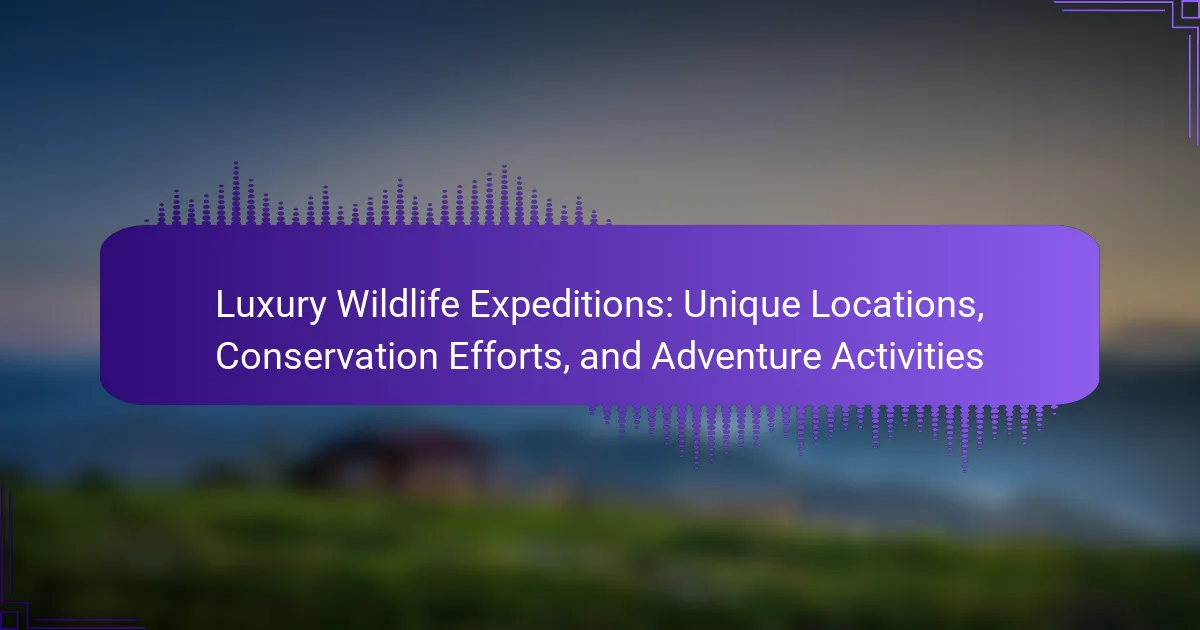Luxury wildlife expeditions provide exclusive access to unique locations while promoting conservation efforts. Travelers can enjoy personalised services, high-end accommodations, and expert-led adventure activities. Popular destinations include Africa’s Serengeti, Costa Rica’s rainforests, and the Galápagos Islands, each offering immersive wildlife encounters. These expeditions also support local communities and sustainable practices, ensuring a positive impact on the environment.
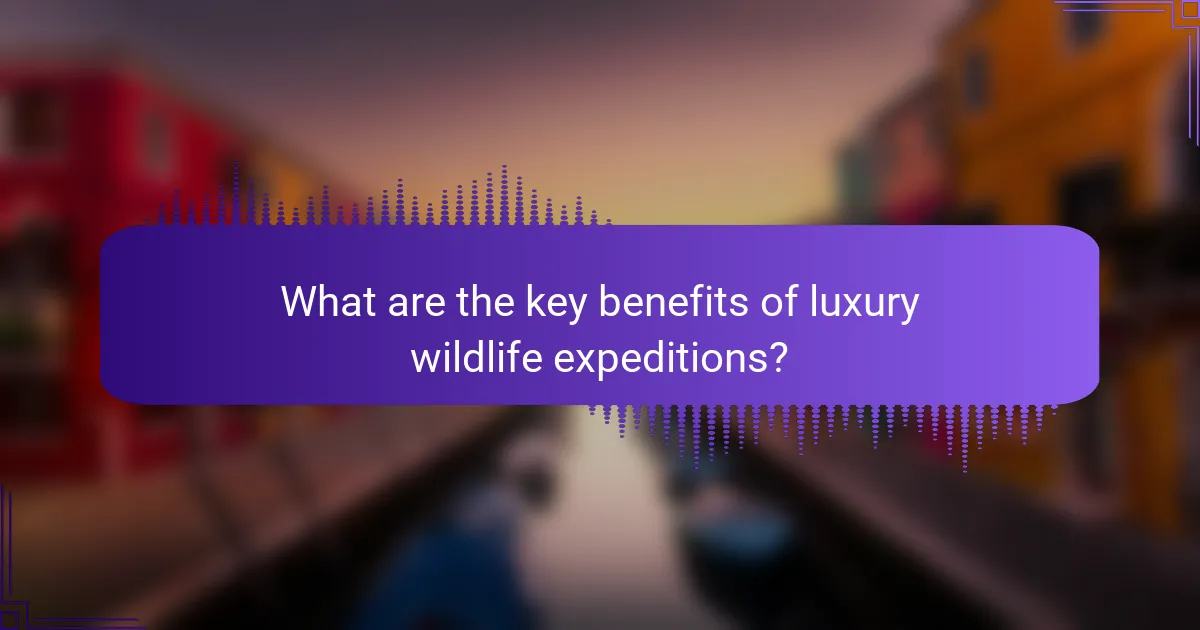
What are the key benefits of luxury wildlife expeditions?
Luxury wildlife expeditions offer exclusive experiences that combine adventure with conservation. Key benefits include access to unique locations, immersive wildlife encounters, and contributions to environmental efforts.
Travelers enjoy personalised services, high-end accommodations, and expert guides who enhance the adventure. These expeditions often support local communities and promote sustainable practices, ensuring a positive impact on the environment.
Additionally, luxury wildlife expeditions provide opportunities for unique activities such as private safaris, guided nature walks, and exclusive wildlife photography sessions. These experiences create lasting memories while fostering a deeper appreciation for nature.
How do luxury wildlife expeditions enhance conservation efforts?
Luxury wildlife expeditions significantly enhance conservation efforts by generating funds and raising awareness. These high-end tours attract affluent travelers who contribute to local economies and support conservation projects. For example, luxury lodges often invest in habitat preservation and wildlife protection initiatives.
Additionally, these expeditions promote sustainable tourism practices. They prioritise low-impact activities, ensuring minimal disruption to ecosystems. This approach encourages the preservation of unique locations, such as pristine national parks or remote wildlife reserves.
Moreover, luxury expeditions often include educational components, such as guided tours led by conservation experts. This fosters a deeper understanding of biodiversity and the challenges faced by wildlife. As a result, travelers become advocates for conservation, spreading awareness beyond their trip.
In summary, luxury wildlife expeditions create a symbiotic relationship between tourism and conservation, benefiting both the environment and local communities.
Why do travelers choose luxury wildlife expeditions over traditional safaris?
Travelers choose luxury wildlife expeditions for exclusive experiences, enhanced comfort, and commitment to conservation. These expeditions often take place in unique locations that traditional safaris do not access, providing intimate wildlife encounters.
Luxury wildlife expeditions emphasise sustainable practices, contributing to local conservation efforts. Travelers appreciate knowing their trips support wildlife preservation and community development. Adventure activities like private guided tours, gourmet dining, and luxurious accommodations elevate the experience beyond conventional safaris.
Additionally, luxury expeditions offer personalised itineraries tailored to individual interests, ensuring a unique adventure. This level of customisation is a rare attribute that distinguishes luxury wildlife experiences from traditional options.
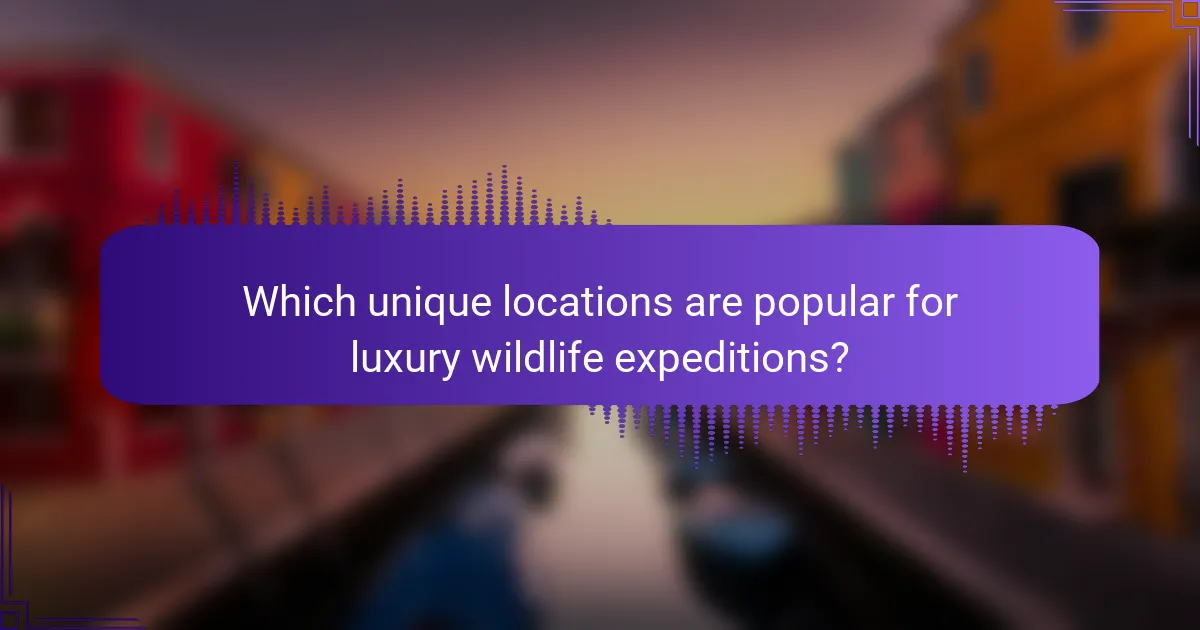
Which unique locations are popular for luxury wildlife expeditions?
Popular locations for luxury wildlife expeditions include Africa’s Serengeti, Costa Rica’s rainforests, the Galápagos Islands, and India’s tiger reserves. Each offers unique experiences and conservation efforts.
1. Serengeti, Tanzania | Known for the Great Migration, offers luxury lodges and guided safaris.
2. Costa Rica | Features diverse ecosystems, luxury eco-lodges, and adventure activities like zip-lining.
3. Galápagos Islands, Ecuador | Renowned for unique species and luxury yacht cruises for wildlife viewing.
4. Ranthambore, India | Famous for tiger sightings and luxury resorts near national parks.
5. Botswana | Offers exclusive safaris in the Okavango Delta with high-end tented camps.
6. Madagascar | Home to unique wildlife, featuring luxury eco-resorts and guided tours.
What makes the Galapagos Islands a prime destination for luxury wildlife experiences?
The Galapagos Islands are a prime destination for luxury wildlife experiences due to their unique biodiversity and conservation efforts. Visitors encounter rare species like the Galapagos tortoise and marine iguanas. Luxury expeditions often include personalised tours led by naturalists, ensuring intimate wildlife interactions. The islands’ commitment to conservation enhances the experience, allowing travelers to support sustainable practices while enjoying breathtaking landscapes. Adventure activities such as snorkelling and hiking further enrich the journey, making each visit memorable.
How does the Serengeti offer exclusive wildlife encounters?
The Serengeti offers exclusive wildlife encounters through its vast landscapes and rich biodiversity. Luxury wildlife expeditions provide unique opportunities to observe iconic species like lions, elephants, and wildebeests in their natural habitat. Conservation efforts in the region enhance these experiences by ensuring sustainable tourism practices. Adventure activities such as guided safaris and hot air balloon rides further immerse visitors in the stunning scenery and wildlife dynamics, creating unforgettable moments.
What are the advantages of exploring the Amazon Rainforest in luxury?
Exploring the Amazon Rainforest in luxury offers unparalleled comfort, unique wildlife encounters, and enhanced conservation support. Luxury expeditions provide exclusive access to remote areas, ensuring minimal environmental impact while maximising adventure. Travelers enjoy personalised experiences, expert guides, and high-end amenities, promoting both relaxation and exploration. Additionally, luxury tours often contribute to local conservation efforts, supporting sustainability initiatives that protect the rainforest and its biodiversity.
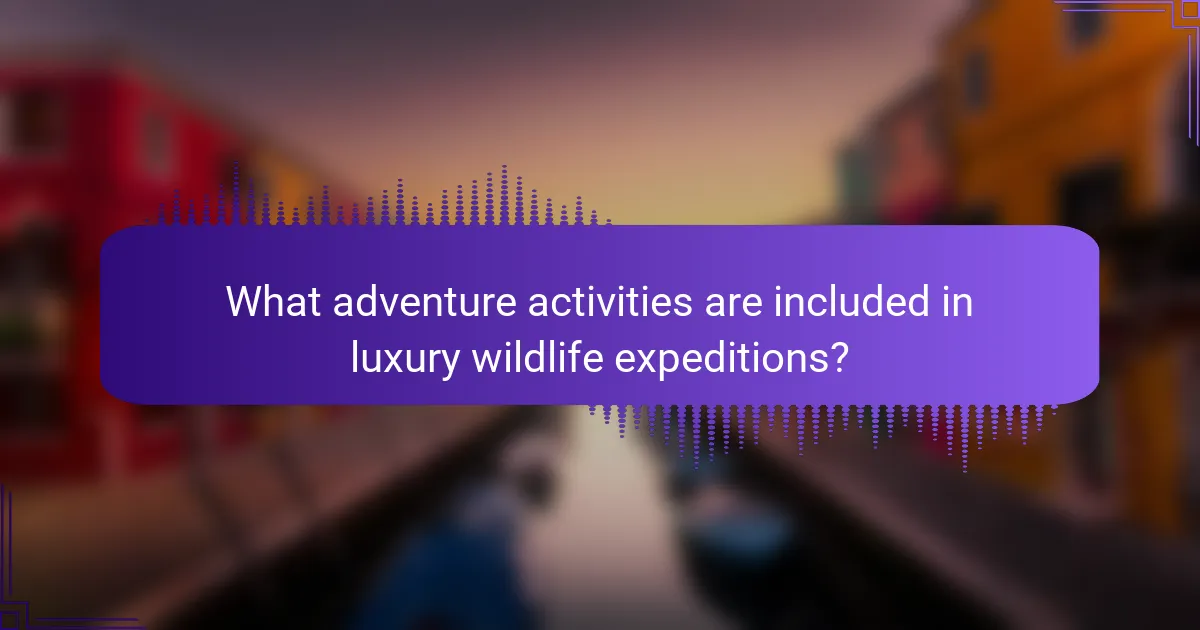
What adventure activities are included in luxury wildlife expeditions?
Luxury wildlife expeditions include activities such as guided safaris, wildlife photography, birdwatching, and eco-friendly hiking. These experiences are designed to immerse participants in unique locations while promoting conservation efforts. Adventure activities often feature expert-led excursions, allowing travelers to observe animals in their natural habitats. Unique attributes of these expeditions include luxury accommodations and personalised itineraries, enhancing the overall experience.
How does guided photography enhance the expedition experience?
Guided photography significantly enhances the expedition experience by providing expert insights and techniques. Participants gain access to unique wildlife moments, improving their skills while capturing stunning images. This immersive approach fosters a deeper connection to nature and conservation efforts. Additionally, guided sessions often lead to unexpected encounters, enriching the overall adventure.
What role do luxury lodges play in adventure activities?
Luxury lodges enhance adventure activities by providing comfort, exclusive access to unique locations, and supporting conservation efforts. These lodges often serve as bases for activities like wildlife safaris, hiking, and eco-tours. Their presence promotes sustainable tourism, benefiting local ecosystems and communities. Additionally, luxury lodges typically offer expert guides, ensuring enriching experiences while prioritising safety and education.
Which unique local experiences can travelers expect during their expeditions?
Travelers can expect immersive encounters with local wildlife, cultural interactions, and exclusive access to pristine environments during luxury wildlife expeditions. Unique locations such as private reserves offer tailored experiences, while conservation efforts enable guests to contribute to wildlife protection. Adventure activities may include guided safaris, birdwatching, and eco-friendly excursions, enriching the travel experience with both excitement and purpose.
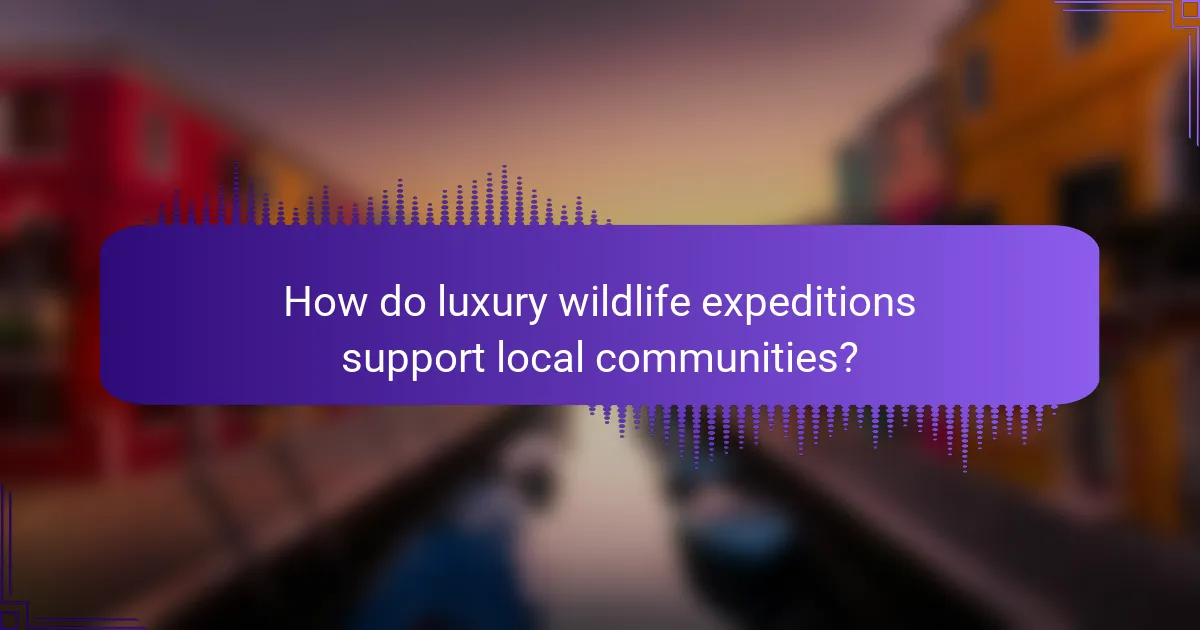
How do luxury wildlife expeditions support local communities?
Luxury wildlife expeditions support local communities by providing economic benefits and promoting conservation. These trips often involve hiring local guides, which creates jobs and stimulates local economies. Additionally, a portion of expedition fees frequently funds community projects, enhancing education and healthcare. Conservation efforts tied to these expeditions help protect wildlife habitats, benefiting both the environment and local populations reliant on these ecosystems.
What partnerships exist between luxury expeditions and conservation organizations?
Luxury wildlife expeditions often collaborate with conservation organizations to enhance their environmental impact. These partnerships focus on protecting endangered species, preserving habitats, and promoting sustainable tourism practices. For instance, expeditions may contribute a portion of their profits to conservation efforts or engage in joint research initiatives. Notable partnerships include those between luxury safari companies and wildlife foundations that work to combat poaching and restore ecosystems. These collaborations not only provide financial support but also raise awareness among travelers about the importance of conservation.
How do luxury expeditions promote sustainable tourism practices?
Luxury expeditions promote sustainable tourism by prioritising conservation, supporting local communities, and minimising environmental impact. They often collaborate with conservation organizations to protect wildlife and habitats, ensuring that tourism benefits the ecosystem.
Unique locations such as remote national parks and marine reserves are chosen for their biodiversity and ecological significance. Adventure activities are designed to be low-impact, allowing travelers to engage with nature responsibly.
Furthermore, luxury wildlife expeditions often incorporate educational components, raising awareness about conservation efforts among participants. This approach fosters a deeper appreciation for nature and encourages travelers to advocate for sustainable practices beyond the expedition.
As a result, luxury expeditions serve as a model for sustainable tourism, balancing adventure with ecological responsibility.
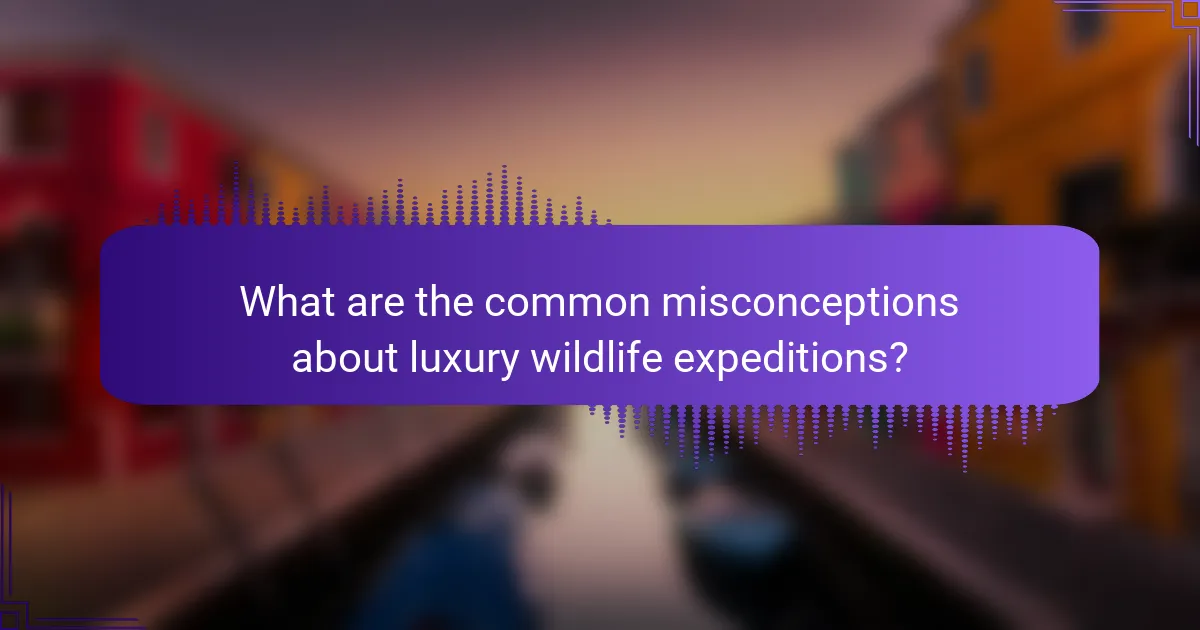
What are the common misconceptions about luxury wildlife expeditions?
Many believe luxury wildlife expeditions prioritise comfort over conservation, which is a misconception. These trips often support local ecosystems and wildlife protection initiatives. Additionally, some think they are only for the wealthy, while various options cater to different budgets. Another common myth is that such expeditions lack genuine adventure; however, they frequently include immersive experiences like guided safaris and wildlife tracking. Lastly, the idea that luxury equates to excess is misleading; many luxury providers emphasise sustainable practices and responsible tourism.
Why are luxury wildlife expeditions not just for affluent travelers?
Luxury wildlife expeditions appeal to more than affluent travelers due to their focus on immersive experiences and conservation efforts. These trips often provide unique opportunities to engage with nature, participate in local cultures, and support wildlife preservation initiatives. Many organizations offer scholarships or discounted rates for students and conservationists, making such adventures accessible. Additionally, group tours can lower costs, inviting a broader audience to experience these enriching journeys. By prioritising education and environmental stewardship, luxury wildlife expeditions create value that transcends financial barriers.
How do luxury wildlife expeditions differ in terms of environmental impact?
Luxury wildlife expeditions generally have a lower environmental impact due to their focus on sustainability and conservation. These trips often prioritise eco-friendly practices, such as using local guides and minimising waste.
Unique attributes include partnerships with conservation organizations, which help protect habitats and wildlife. Many luxury expeditions contribute a portion of their profits to local conservation efforts, enhancing their positive impact.
Rarely, some luxury expeditions may engage in practices that harm the environment, such as off-road driving in sensitive areas. However, responsible operators actively avoid such practices to preserve ecosystems.
Overall, the emphasis on sustainability in luxury wildlife expeditions sets them apart from traditional tourism, promoting environmental stewardship while providing unique experiences.
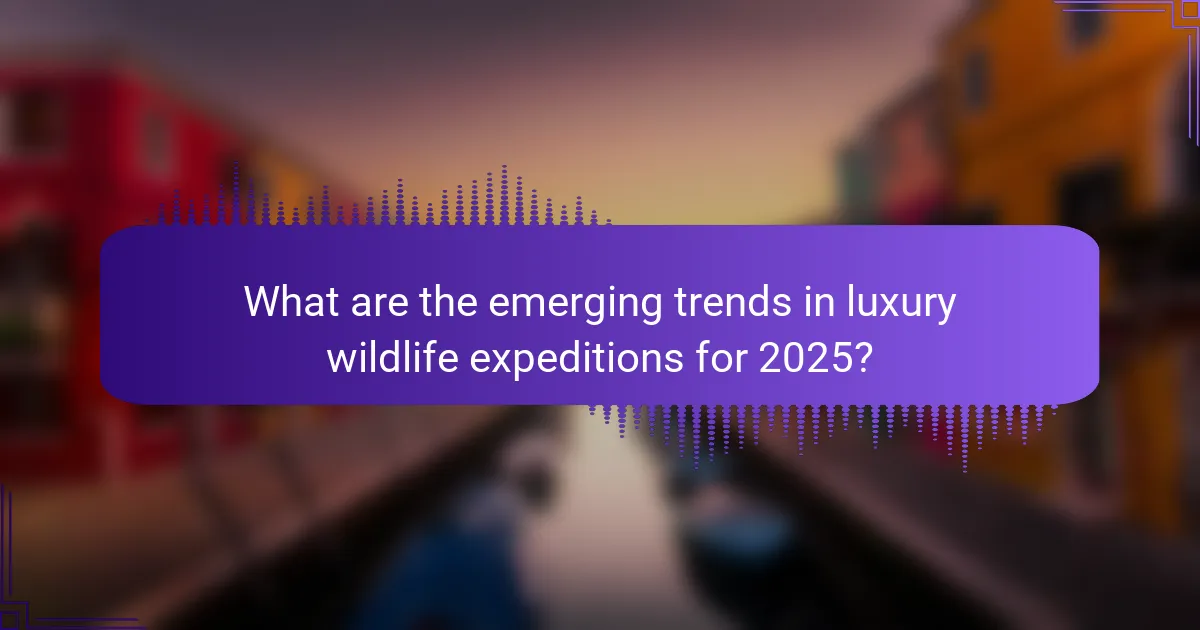
What are the emerging trends in luxury wildlife expeditions for 2025?
Emerging trends in luxury wildlife expeditions for 2025 focus on immersive experiences, sustainable practices, and personalised adventures. Travelers seek unique locations that prioritise conservation and offer exclusive access to wildlife.
In 2025, luxury expeditions will increasingly feature private guided tours in remote areas, enhancing the sense of adventure. Innovations in eco-friendly accommodations will support conservation efforts while providing comfort.
Adventure activities will evolve to include wellness retreats integrated with nature, such as yoga safaris and guided meditation in wildlife-rich environments. This approach fosters a deeper connection with the ecosystem.
Moreover, technology will play a significant role, with virtual reality enhancing pre-trip experiences, allowing travelers to preview their adventures. This trend caters to the growing demand for unique and memorable travel experiences.
How is technology shaping the future of luxury wildlife experiences?
Technology is transforming luxury wildlife experiences by enhancing accessibility, personalization, and conservation efforts. Virtual reality offers immersive previews of expeditions, while mobile apps provide real-time information about wildlife. Drones and camera traps aid conservationists in monitoring animal populations, ensuring sustainable practices. Smart sensors help track environmental changes, enabling tailored experiences that prioritise both adventure and ecological responsibility.
What innovative conservation methods are being introduced in luxury expeditions?
Luxury wildlife expeditions are introducing innovative conservation methods like community-based tourism and wildlife monitoring technology. These approaches enhance local engagement and provide data for protecting endangered species. For example, some expeditions incorporate eco-friendly practices such as solar power and waste reduction initiatives, minimising environmental impact. Additionally, partnerships with conservation organizations allow expeditions to support habitat restoration and promote sustainable practices among travelers.
Which new destinations are gaining popularity for luxury wildlife adventures?
New luxury wildlife adventure destinations include Botswana, Rwanda, and the Galápagos Islands. These locations offer unique experiences, such as tracking endangered species and immersive eco-lodges. Botswana’s Okavango Delta features exclusive safari experiences, while Rwanda’s gorilla trekking is renowned for conservation efforts. The Galápagos Islands provide unparalleled opportunities to observe diverse wildlife and engage in sustainable tourism practices.
What are the best practices for planning a luxury wildlife expedition?
To plan a luxury wildlife expedition effectively, prioritise unique locations, conservation efforts, and adventure activities. Choose destinations renowned for their biodiversity and luxury accommodations. Collaborate with local conservation organizations to ensure responsible travel practices. Incorporate exclusive experiences, such as private guided tours and bespoke itineraries, to enhance the adventure.
